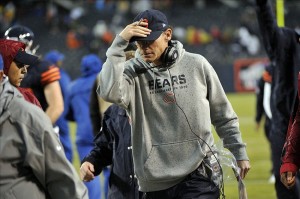In week 11, the Bears led the Ravens by three with two minutes remaining. After the two-minute warning, Joe Flacco completed an 11-yard pass that brought Baltimore to the Bears’ 16-yard line. The Ravens next snap took place with 1:21 remaining, and Ray Rice picked up 11 yards to put the Ravens at the Chicago 5-yard line with 75 seconds left.
Baltimore then let the clock run, snapping the 1st-and-goal play with 36 seconds left (Ray Rice ran for three yards). After waiting a few seconds, the Ravens called timeout with 23 seconds remaining. On second down, the Ravens ran Rice again, but he lost a yard, and Baltimore used its final timeout with 11 seconds left. Flacco’s third down pass went incomplete, and Baltimore kicked a field goal to force overtime, giving Chicago the ball back with just three seconds.
This was the rare case where both teams managed to lower their odds of winning with poor clock management. Baltimore had two timeouts and 36 seconds to run three plays. The worst option would be to call timeout after the 1st down and 2nd down plays: the goal should be to keep a timeout for after the third down play. By saving that timeout, the team retains the option of running on 3rd down, and also has a safety net in the event of a sack. There’s no reason why a team needs to call one timeout after 1st-and-goal and another after 2nd-and-goal. For a man who sleeps at the office to get every edge he can, John Harbaugh lowered his team’s odds of winning by not knowing when to use his timeouts. This is not just an academic point, either: Flacco nearly lost the third down snap, which could have ended in an embarrassing loss for the Ravens. [1]Also, the predictable run-run-pass playcalling won’t win Harbaugh any awards, either. A second down pass to the end zone solves all of these problems, too.
But Harbaugh’s poor use of timeouts — while inexcusable — didn’t lower his team’s odds of winning significantly. That task was handled by Marc Trestman. After Rice ran down to the 5-yard line, Trestman should have called timeout with 75 seconds remaining — instead, he allowed Baltimore to run the clock all way to 36 seconds left (Baltimore snapped it with 3 seconds left on the play clock). On that play, Rice nearly ran for a touchdown, which shows how foolish this decision was by Trestman. The mere fact that Baltimore bled the clock for 39 seconds is prima facie evidence that the Bears erred by not calling timeout. Football is a zero-sum game, so if it was good for Baltimore to let the clock run down, it must have been bad for Chicago to allow the Ravens to do that. Think of it this way: would Ravens fans have been happy or sad to see Trestman call timeout in that situation?
The interesting part of this situation is we actually got to find out what Trestman was thinking. Adam Hoge transcribed the head coach’s Monday press conference, where he said:
[continue reading…]
References
| ↑1 | Also, the predictable run-run-pass playcalling won’t win Harbaugh any awards, either. A second down pass to the end zone solves all of these problems, too. |
|---|

